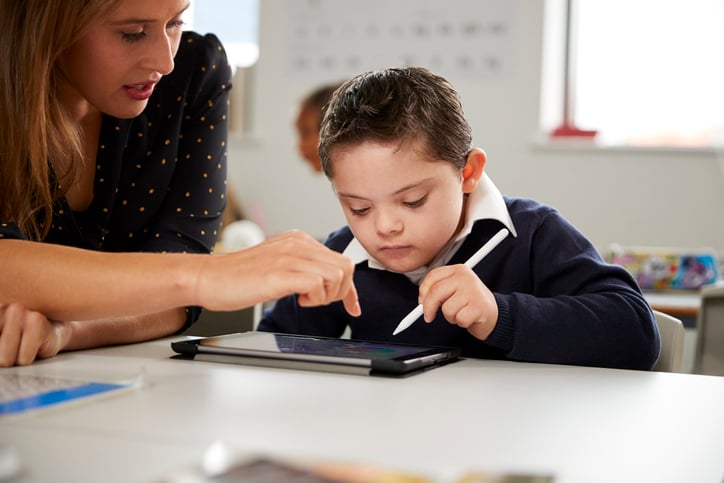Assessing the Effectiveness of Special Education Products
To determine the effectiveness of the products used in your special education program, it's important to reflect on the following key considerations:
- Curriculum Materials and Resources
- Are the curriculum materials relevant, age-appropriate, and aligned with state standards?
- Do they provide multiple means of representation, expression, and engagement?
- Are they compatible with assistive technologies and adaptive equipment?
- Assistive Technologies and Adaptive Equipment
- Are assistive technologies and adaptive equipment readily available to students who need them?
- Are they properly maintained and updated as needed?
- Are staff members trained in their appropriate use and integration into instruction?
- Instructional Software and Digital Tools
- Do the instructional software and digital tools support the specific learning needs of students with disabilities?
- Are they user-friendly and accessible for both students and staff?
- Do they provide meaningful data and feedback to inform instruction and progress monitoring?
- Sensory and Therapeutic Aids
- Are sensory and therapeutic aids incorporated into the learning environment as needed?
- Do they support students' self-regulation, focus, and emotional well-being?
- Are they used in conjunction with other evidence-based strategies and interventions?
- Alignment with Individual Needs and IEP Goals
- Are the products and resources aligned with the specific needs and IEP goals of individual students?
- Do they support progress toward measurable objectives and outcomes?
- Are they regularly evaluated and adjusted based on student performance and feedback?

Strategies for Enhancing Special Education Products
Based on your assessment of the products used in your special education program, consider the following strategies for improvement:
- Conduct a Comprehensive Inventory
- Identify all products and resources currently used in your program
- Evaluate their relevance, effectiveness, and alignment with student needs
- Determine gaps or areas where additional resources may be needed
- Research and Evaluate Options
- Explore evidence-based products and resources that address identified needs and gaps
- Evaluate potential options based on factors such as accessibility, user-friendliness, and compatibility with existing resources
- Consider pilot testing new products with a small group of students and staff
- Provide Professional Development and Support
- Offer targeted training for staff on the effective use and integration of products into instruction
- Provide ongoing support and coaching to ensure fidelity of implementation
- Encourage collaboration and sharing of best practices among staff members
- Involve Stakeholders in the Process
- Seek input from teachers, related service providers, and other specialists on product selection and implementation
- Engage parents and families in discussions about their child's needs and the role of products in supporting their learning
- Solicit feedback from students on their experiences with different products and resources
- Monitor and Adjust Based on Data
- Regularly collect and analyze data on student performance and progress in relation to the products used
- Use this data to inform decisions about continuing, modifying, or discontinuing the use of specific products
- Continuously evaluate the effectiveness of products and make adjustments as needed to maximize student success
Conclusion
The products and resources used in special education are not just tools – they are essential elements of a comprehensive and effective program. By focusing on the "Products" component of the 5P Framework, special education leaders can ensure that their programs are equipped with evidence-based, accessible, and individualized resources that support student success. Through a systematic approach to assessing and enhancing these products, educators can create a more inclusive and impactful learning environment that meets the unique needs of all students with disabilities. By prioritizing this critical aspect of the 5P Framework, special education programs can maximize their potential to support student growth, development, and achievement.
.jpeg?width=1754&height=1050&name=ARIS%20User%20Portal%20Trainer%202%20(2).jpeg)
Language Builder ARIS Curriculum
One evidence-based curriculum that can be a valuable addition to any special education program is the Language Builder: Academic Readiness Intervention System (ARIS). Designed by experts in autism education, ARIS offers a comprehensive toolkit of resources, including detailed lesson plans, customized data tracking, and a wide array of visual and manipulative materials. Aligned with the principles of Applied Behavior Analysis (ABA) and correlated with key educational standards, ARIS focuses on building foundational skills and promoting academic readiness for students with autism and other language delays.
By incorporating research-based products like ARIS into their programs and following the 5P Framework to evaluate and enhance their resources, special education leaders can ensure they are providing students with the tools they need to succeed. Through a systematic approach to assessing and improving the products used in special education, educators can create more inclusive, effective, and impactful learning environments that support the growth, development, and achievement of all students with disabilities.
This article is part of a 5-part series on Stages' 5P Framework: People, Place, Practices, Procedures, and Products. The articles in this series include:








